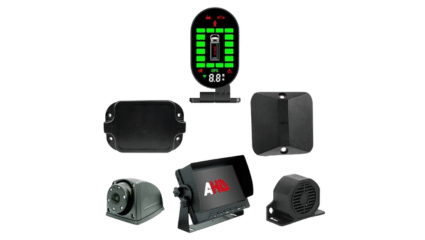Direct Vision Standards (DVS)
Products:

Direct Vision Standard (DVS) 2024
More infoDirect Vision Standard (DVS) 2024
From October 2024, the minimum DVS rating will be three stars. As a result, vehicles rated two and below on the DVS rating scale, as well as unrated vehicles, are required to be fitted with the Progressive Safe System (PSS).
The minimum DVS rating will be three stars as of October 2024. Consequently, vehicles rated two and below on the DVS rating scale, including unrated vehicles, will be required to be equipped with the Progressive Safe System (PSS).
Through our partnership with Fonix Telematics, we offer solutions that meet these needs.
Nearside blind spot camera monitoring system (BSIS)
The nearside blind spot must be completely eliminated by installing a camera monitoring system, regardless of whether mirrors are fitted. In order to minimise the amount of time the driver takes off their eyes from the road to see the monitor, in cab monitors should be placed close to a window edge or existing mirror (without obscuring the view through the window).
Mirror replacement camera systems can also be used instead of fitting Class V and VI mirrors. Mirror replacement cameras and monitors intended just for low-speed manoeuvring may shut off at speeds exceeding 20mph. Where an existing camera monitoring system already exists in a vehicle, such as replacing mirrors, an additional camera monitoring system is not required, and the same safety benefits are obtained.
Sensors for blind spots on the near side
To ensure full coverage down the nearside of the vehicle, blind spot information systems must be installed on the vehicle. In the event of an imminent collision, sensors must not respond to roadside furniture or stationary vehicles. It is essential that the sensors on articulated vehicles are positioned so they will provide sufficient coverage of the nearside of the combination without being activated by the trailer itself. A semi-trailer’s rear side must be detected by sensors, and this zone must extend rearward into the surrounding area.
MOIS (Moving Off Information Systems)
When the vehicle is stationary with the brakes applied, the front sensor system must trigger a proximity information signal to the driver to detect pedestrians or cyclists entering the critical blind spot area in front of the vehicle. Whenever the driver begins preparing the vehicle to move from a resting position, the signal must escalate to a collision warning. The front sensor system should be ‘active’ and able to detect vulnerable road users. It is essential that they do not provide false alarms. A visual signal must be provided to indicate when a vulnerable road user has been detected in the detection area, according to the technical specifications. When the vehicle moves off with the vulnerable road user detected, a collision becomes imminent, and an audible alarm signal should sound.
Audible Alarm
A vehicle must be equipped with an audible warning system to alert pedestrians, cyclists, and other road users of its intention to turn. The audible warning volume should range between 65 and 88 decibels/dB(A), measured one metre away from the sounder. It is recommended that operators consider combining spoken warnings with white noise in an audible warning system. The use of audible warning devices should require minimal driver intervention. A manual on/off switch should be built into the device to enable its use between the hours of 23:30 and 07:00.
Left-hand drive vehicles must have an audible vehicle manoeuvring warning to warn people walking and cycling when turning right.
External pictorial stickers and markings
It is mandatory to display warning signs on the rear of the rigid vehicle and any trailer unit in use, and not on the front tractor unit. Pedestrians and cyclists must be made aware of the hazards posed by the vehicle when near it. There must be no offensive signage or instructional advice for people walking and cycling. At a reasonable distance from the vehicle, cyclists and pedestrians must be able to read the text point size. It is recommended that signs be at least A3 in size.
Side under-run protection
To minimise the severity of under-run collisions, vehicles should be equipped with appropriate side under-run protection. It must be provided on both sides of the vehicle unless doing so would be demonstrably impractical. Operators should consider improving sideguard design, such as flat panel sideguards. It is mandatory that any side under-run protection installed complies with the requirements set forth in UNECE Regulation 73.
